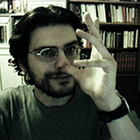OTB crew
past and present.
Bruce Anderson our shepherd
Bruce worked for 20 years as a university teacher and researcher and 15 years as a consultant and software architect at IBM. He was a professor of computer science at University of Essex where he investigated principles of architecture and software design. He has bicycled around the world, climbed the tallest trees in America and meditated to the fifth level of enlightenment. He asks very good questions, is a kind leader and a friend to ducks everywhere.

You'll find Bruce on page 'xi' of the "Design Patterns" book and in the History of Patterns
Bruce didn't realise he was more of an engineer than a scientist until he was about 29 years old. By then, he had an Oxford MA (in Physics), an Edinburgh MSc (in Artificial Intelligence), a couple of years in the US mainly at the Stanford AI Lab, a year in CS at Essex doing AI and a new job in the Essex Electronics department. He then worked as a Senior Managing Consultant in IBM Global Services (techie branch) where he shared, applied and developed his ideas.
Now he's retired, doing almost no IT and keeping busy without being paid.
Bruce worked in many kinds of organisations and many different industries, in many roles, but his abiding interest is in learning and "what practitioners know". He initiated a series of workshops on the "Architecture Handbook", playing a part in the early days of the Patterns movement. Bruce has run many learning workshops, including several pan-European interactive events with a highly participative and empowering style for 160 participants. Jointly with Steve Cook Bruce led the creation of the OT (now SPA) series of conferences in the UK (now in their twenty-second year), and have run several OOPSLA workshops.
Bruce knows that people love to collaborate and learn together and from each other, when they are free to do so - free from unnecessary pressure and free from false models of learning and knowledge. Such people enjoy life and work productively.

John Pagonis
John invested too many (he thinks) years developing smartphone OS software so now he is having fun developing software for machine learning and recommender systems. When he grows up he wants to become a great software engineer and score a win over information overload. In the mean time he helps teams develop better software with Scrum.

Sotiris Sotiropoulos
Sotiris spent his Padawan years painting fantastic worlds as an indie game artist. Nowadays he has the same job description as C3PO: Human-Cyborg relations or UI/UX Design, which means his artistic skills have been transferred to interfaces and interactions. Combining methodologies such as Agile, Lean and Human-Centered design in his work process he tries to make Earth a better place to live, free of design flaws and ugly stuff.

Vassilis Vatikiotis
Vassilis saw a ZX Spectrum+ on the table and while he had never seen or even heard anything about computers, he knew it was something beautiful and magical. Fast forward to the present and after several programming and engineering positions, he still thinks that computers are indeed these magical objects which help us shape our environment. Being a builder at heart has never been so rewarding! These days Vassilis shares his time as a system engineer at a research institute and as a Web UI developer.

Vassilis Rizopoulos
Vassilis is one of the redshirt survivors of EuRuKo 2013 and co-founder of thessaloniki.rb and has been pretending - somewhat successfully - to be an embedded software developer for over a dozen years now. Working for Zühlke, he invents ways to introduce Ruby and the joys of devops to industry giants like Siemens, Lenze, Roche or Liebherr bridging the world of the web and the cloud with the physical reality of embedded devices.

Dimitris Papanikolaou
Dimitris wanted to be a musician but in the end another type of keyboard won his heart. He has been programming for over 20 years, having started with assembly and worked all his way up to smartphone application development. Being an avid learner of all things software he seeks opportunities to be taught and occasionally teach others.

Stefanos Togoulidis
Stefanos used to program his Apple //e in hex when his friends were boasting about their CGA cards. He still likes to poke into and program the devices he owns. His next goal is to wrap his head around Haskell, on some real world smartphone app preferably...
Copyright 2015 - 2017 by the OTB crew, hack at will.